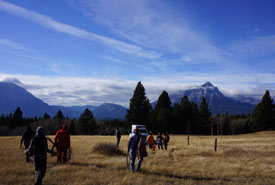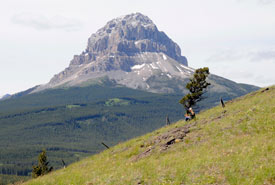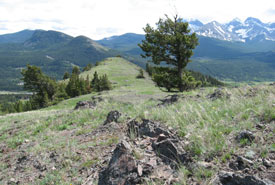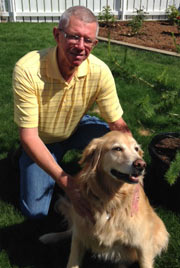Alberta's ranching evolution (Part One)

Boholomec Ranch, Crowsnest Pass (Photo by NCC)
For me, there is something about the Canadian prairies. It’s not where I originally came from, but when I moved west to Saskatchewan and Alberta from Ontario some 36 years ago, they just took me in, and I knew I could not ever stop living under their endless skies. Prairies or whatever their various expressions — rangelands or grasslands — are a huge and delicate environment with a long history of conflict, misunderstanding and romance.
Before exploration of the Canadian west began, the rangelands were occupied by the Algonkians, composed of the Cree, Blackfoot and Siouan. These tribes depended on the buffalo for almost all their needs — food, clothing and shelter — and thus had to migrate with the roving herds, whose population, by conservative standards, was close to 30 million head during the early 1800s. Within each tribe, no one person owned more of the land than another. Material possession was not nearly as important as was the preservation of values passed on through each tribes’ generations. This concept was based on respect for the land, and time rather than space; thus, land could not be sold but was passed on to successive generations of children to live on and cultivate for subsistence.
Unlike the indigenous people of Canada, ownership of land in the European sense was through fee simple title. The Europeans thought in terms of space, and the premise that the amount of land under ownership was a reflection of an individual's wealth and power.
Between 1857 and 1860, the prairie landscape’s suitability for settlement was first assessed by Captain John Palliser. His recommendations concluded that the land was generally too barren and the absence of valuable timber and precipitation precluded both successful farming and agricultural settlement. His observations were later used by the early frontiersmen from eastern Canada and the mid-western United States to encourage the national government to sell or lease huge tracts of land for ranching at very favourable prices.

Boholomec Ranch (Photo by Bob Lee)
The movement of small cattle herds into the foothills of the southwestern territories of Canada first began with the westerly migration of Europeans from Upper Canada and the eastern townships. Spurred on by dreams of waist-high green grass and crystal-clear waters, they were joined by northward-bound American ranchers from Texas and Montana and as far away as Chicago. Lured by the adventure of maintaining law and order, the North-West Mounted Police began to make their presence known; of central importance to western development and to the stock-raising industry.
In particular, the police provided security and safety to the cattle producers, who preferred to let their cattle graze unattended on the rangelands. The police were also responsible for suppressing the whiskey trade, and establishing a friendly rapport with the indigenous population. Combined with their knowledge of the burgeoning cattle industry, the North-West Mounted Police were instrumental in drawing the attention of other easterners to the ranching potential of the west.
In 1883, and following the arrival of the Canadian Pacific Railway in Calgary, the ranching and cattle industry was born in Alberta. By 1885, cattle were grazing in the foothills of the Rockies as far north as Calgary, along the Bow River Valley and south over three hundred kilometres to the American border.
The movement of cattle into the Canadian rangelands was inevitable. Ranchers have long sought out the same things — creeks and springs, temperate climate and good grass. Similar to the previously settled areas of western Montana, this region in the foothills of the eastern Rockies possessed a unique climatic feature — the chinook, or snow-eater. It brought warm, dry winter winds that regularly melted the snows and exposed the grasslands for winter pasture. The desiccating winter wind, combined with excessive summer evaporation, rendered the region semi-arid and less favourable for crop agriculture, and therefore less favourable for the influx of the granger (or, as they were better known then as, the sod-buster).
The number of sod-busters that the ranchers would one day have to contend with were limited, due to a lack of knowledge of dry-weather farming techniques. The region also enhanced cattle raising with the presence of highly nutritious short grass vegetation and the numerous coulees that furnished natural shelter. And water, the contentious resource, predicating that, as the saying goes, “whoever controls the water, controls the land.”
The earliest cattle operations in Alberta in the 1870s and 1880s would emerge, with the establishment of ranches such as the Oxley, the Waldrond, the Bar U and the Cochrane, incorporating vast tracts of the prairie where ranchers fed and raised their cattle over immense acres of what was previously the habitat of moose, deer, elk and bear.

Boholomec Ranch (Photo by Rangeland Conservation Service)
In the summer of 1881, however, Sir John A. MacDonald sent out land surveyors in advance of wave after wave of “gentlemen” farmers, whose sole purpose was to develop the west and contribute to Canada’s gross national product through new agricultural techniques. These farmers would flood to Alberta from eastern Europe and the British Isles to start smaller ranches, and adopt agricultural techniques that would signify the birth of modern day cattle range management. It would signify the end of the freedom era of the Great Plains, as land was increasingly divided into 160-acre (65-hectare) plots, considered to be marketable as give-away homesteads.
The wild wilderness came to an end. Wildlife corridors soon began to disappear, and habitat connectivity would become fragmented.
Stay tuned for Part Two of this blog, coming out on April 27, where I will walk you through the history of a Nature Conservancy of Canada property called the Boholomec Ranch.


